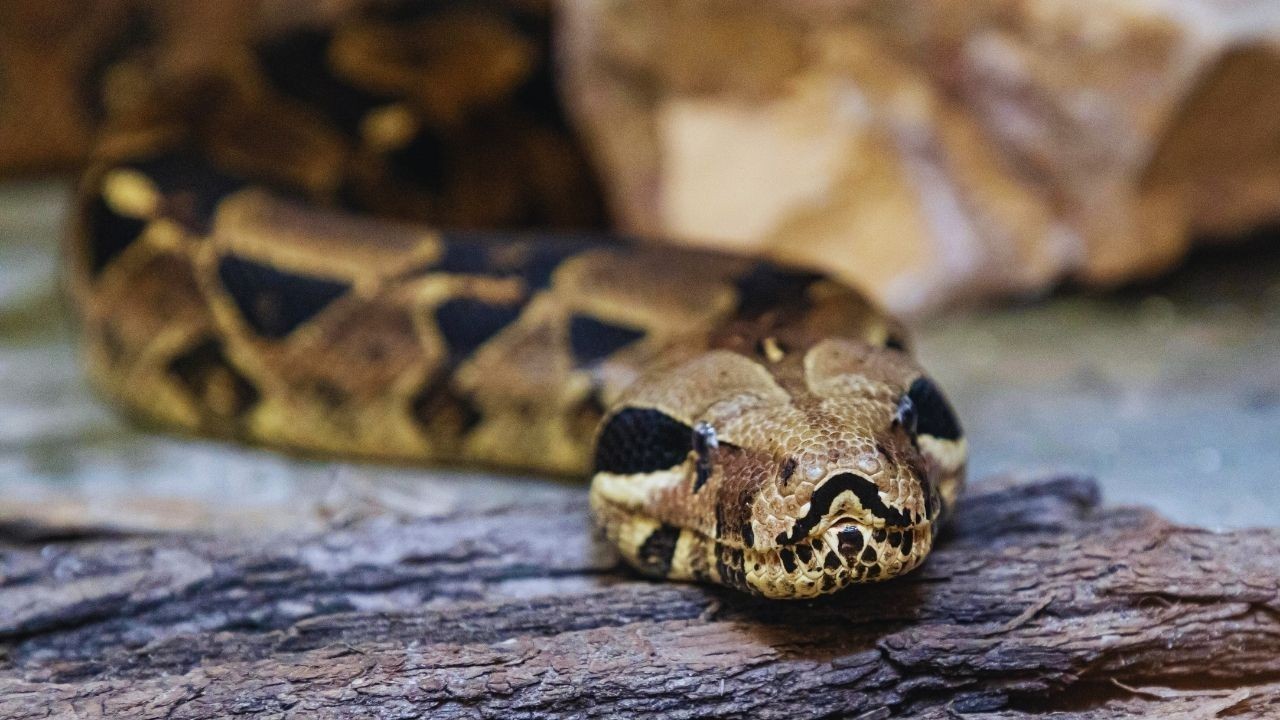
Post by : Anish
Kerala, with its dense tropical forests, backwaters, wetlands, and fertile plains, is often celebrated for its natural beauty. However, hidden beneath this enchanting landscape lies another world—one ruled by reptiles, particularly snakes. With nearly 350 species identified in the region, Kerala stands as one of the richest hotspots of snake diversity in Asia. This abundance ranges from venomous snakes like cobras, kraits, and vipers to harmless species that play a vital ecological role. The presence of such variety highlights not only the biodiversity of the state but also the complex relationship between humans and these misunderstood creatures.
Kerala’s ecosystem supports species ranging from the tiny worm snake to the majestic king cobra. While many people instantly associate snakes with danger, the reality is that a vast majority of them are non-venomous. Rat snakes, keelbacks, and vine snakes thrive in villages and wetlands, often living unnoticed. At the same time, dangerous species like Russell’s viper and Indian cobra demand respect due to their venom. This blend of harmless and venomous snakes is what makes Kerala’s reptilian world so fascinating.
Snakes are often feared, but their ecological contributions cannot be overlooked. They play a crucial role in controlling rodent populations, which directly supports agriculture by preventing crop damage. In villages, farmers often notice a balance in rodent numbers when snakes are present nearby. Forest-dwelling snakes also contribute to the food web, preying on insects, amphibians, and small mammals. In turn, they serve as prey for birds of prey and larger animals, maintaining the natural cycle. Kerala’s biodiversity depends heavily on the survival of these reptiles.
One of the most intriguing aspects of Kerala’s snake population is how closely they live alongside humans. In villages and agricultural lands, snakes frequently appear near homes, paddy fields, and even wells. While this sometimes sparks fear, many locals have learned to coexist peacefully. Traditional knowledge in rural areas helps people identify harmless snakes and avoid unnecessary killings. However, incidents of snakebites still occur, particularly during monsoon seasons when reptiles are more active. This has led to a cultural mix of reverence, fear, and caution toward snakes.
Snakes hold a sacred place in Kerala’s culture. Serpent worship, known locally as Naga Aradhana, is still prevalent in many parts of the state. Snake groves or Sarpakkavu—small forest patches preserved for serpents—exist near temples and households. These sacred sites not only reflect spiritual beliefs but also serve as natural sanctuaries where snakes can thrive without human interference. Festivals and rituals centered around snakes continue to influence the spiritual fabric of Kerala, further showcasing the deep-rooted connection between people and these reptiles.
Every year, Kerala’s heavy monsoons bring snakes closer to human settlements. Flooded burrows and waterlogged fields drive snakes into drier areas, often resulting in encounters in homes and public spaces. Hospitals in Kerala see a rise in snakebite cases during this season, making awareness and preparedness essential. Despite the risks, locals often accept these encounters as part of life in a land so intertwined with nature. Efforts by wildlife organizations and local authorities focus on promoting snake rescue operations instead of killing, a step toward conservation and safety.
In recent years, Kerala has witnessed the rise of dedicated snake rescuers and conservationists. These individuals play a vital role in safely capturing snakes that enter human settlements and releasing them back into the wild. Social media and awareness campaigns have helped reshape perceptions, teaching people that not all snakes are threats. Organizations work tirelessly to educate children and farmers about identifying venomous species, understanding snake behavior, and avoiding risky interactions. Such grassroots efforts are crucial to ensuring harmony between humans and reptiles.
Researchers and herpetologists continue to study Kerala’s snake diversity, uncovering new species and understanding their habitats. The Western Ghats, a UNESCO World Heritage site, forms the backbone of this research. Many endemic species are found only in this region, making conservation even more critical. Scientists emphasize the importance of habitat preservation, as urban expansion and deforestation threaten snake populations. Documenting these species also contributes to global biodiversity records, strengthening Kerala’s position as a vital hub for reptile research.
Despite ongoing efforts, snake conservation in Kerala faces multiple challenges. Habitat loss due to deforestation, urbanization, and agricultural expansion disrupts natural ecosystems. Roadkills are another growing issue, with many snakes dying while crossing highways. Fear-driven killings remain common in rural areas, even when the species involved is non-venomous. Addressing these challenges requires not just awareness but also stronger laws and community-driven conservation programs that integrate local traditions with modern science.
Looking ahead, the relationship between humans and snakes in Kerala depends on how well communities adapt to coexistence. Education plays a key role—teaching future generations to respect rather than fear reptiles. Schools, conservation programs, and local campaigns are already making progress in this direction. With the support of government initiatives and cultural practices that honor serpents, Kerala has the potential to set an example for the world in balancing human life with biodiversity.
Kerala’s world of snakes is a story of diversity, mystery, and coexistence. With nearly 350 species spread across its forests, wetlands, and villages, the state represents one of the richest reptilian habitats in Asia. While fear and caution remain natural responses, awareness and conservation efforts are slowly shifting perspectives. Snakes, far from being just dangerous creatures, are integral to the ecological and cultural fabric of Kerala. Protecting them means protecting the balance of nature itself, ensuring that future generations can continue to witness the hidden reptilian world that thrives in this green paradise.
This article is intended for informational and educational purposes only. It is based on general studies and observations about snake diversity in Kerala and should not be considered a substitute for expert advice. Readers are advised to exercise caution and consult wildlife experts when dealing with snakes.

UE Dubai Students Shine at COP30 Simulation in Cairo, Showcasing Global Leadership in Climate Policy
University of Europe for Applied Sciences Dubai (UE Dubai) have taken centre stage at the COP30

Sheikh Hazza Visits Al Shamsi Family, Strengthens Community Ties
His Highness Sheikh Hazza bin Zayed Al Nahyan visits Al Shamsi in Al Ain, engaging with locals and r

Dubai’s PCFC Showcases Smart Tech at GITEX Global 2025
PCFC highlights AI, smart logistics, and digital platforms at GITEX Global 2025, strengthening Dubai

Ghanadah 60ft Dhow Race Set to Sail in Abu Dhabi on October 10
Over 90 dhows will race 25 nautical miles for AED 4.2 million in Abu Dhabi's Ghanadah 60ft Dhow Sail

Emirates Islamic Lists World’s First Sustainability Sukuk
Emirates Islamic lists USD 500M sustainability-linked Sukuk, a global first, boosting Nasdaq Dubai’s

UAE Central Bank Hosts Global Data Leaders Conference
CBUAE hosts global data experts to explore AI, data innovation, and governance, strengthening centra

World Octopus Day: Red Sea Reveals Rare Marine Treasures
Discover the Red Sea's unique octopus species this World Octopus Day, highlighting Saudi Arabia’s ri

UE Dubai Students Shine at COP30 Simulation in Cairo, Showcasing Global Leadership in Climate Policy
University of Europe for Applied Sciences Dubai (UE Dubai) have taken centre stage at the COP30

Signs Your Gut Health May Be Slowing Your Weight Loss
Poor digestion can slow weight loss Learn the key signs your gut may be affecting metabolism and how

Keto Friendly Fruits Top 10 Low Carb Fruits for Weight Loss Success
Discover 10 keto friendly low carb fruits that support weight loss boost energy and keep your die

Rajvir Jawanda Life Career Music Hits & Tragic Accident Explained
Discover Rajvir Jawanda s journey from police aspirant to Punjabi music star his hits acting career

Karwa Chauth 2025 Date Rituals Legends and Modern Celebrations
Discover Karwa Chauth 2025 date rituals legends and modern celebrations highlighting love devotion a

DGHS Enforces No Cough Syrup Rule for Infants Urges Caution for Kids Under Five
DGHS bans cough syrup for infants and urges caution for kids under five to prevent health risks and

From Flying Taxis to Autonomous Delivery Dubai s Smart Transport Revolution
Explore Dubai s smart transport future with flying taxis autonomous vehicles and delivery drones sha

Are You Confusing Social Anxiety with Shyness Learn the Key Differences
Learn how to tell social anxiety from shyness recognize symptoms and get tips to manage anxiety for